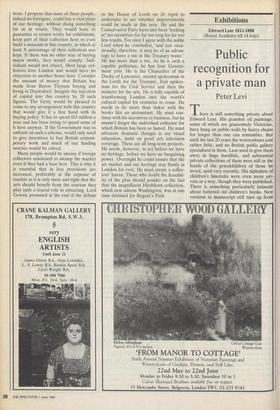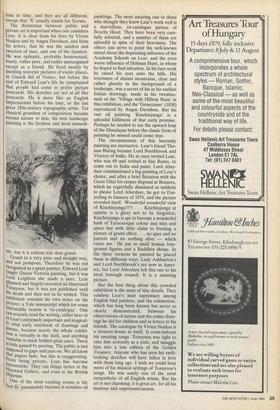Exhibitions
Edward Lear 1812-1888
(Royal Academy till 14 July)
Public recognition for a private man
Peter Levi
There is still something private about Edward Lear. His grandest oil paintings, some of which are gruesomely Victorian, have hung on public walls by heavy chains for longer than one can remember. But until the last 20 years the watercolours cost rather little, and no British public gallery specialised in them. Lear used to give them away in huge handfuls, and substantial private collections of them were still in the hands of the grandchildren of those he loved, until very recently. His alphabets of children's limericks were even more pri- vate in a way, though they were published. There is something particularly intimate about battered old children's books. New versions in manuscript still turn up from time to time, and they are all different, except that 'X' usually stands for Xerxes.
The distinction between public and private art is important when one considers Lear. It is clear from his lives by Vivien Noakes and by Angus Davidson, and from his letters, that he was the saddest and sweetest of men, and one of the funniest. He was epileptic, probably homosexual, lonely, rather poor, and rather unrecognised except as a friend. He lived mostly by Painting souvenir pictures of exotic places, as Guardi did of Venice, but before the end of Edward Lear's life he complained that people had come to prefer picture Postcards. His sketches are not at all like postcards. He is more like an English Impressionist before his time, or the last great 18th-century topographic artist. Yet classical grandeur of composition became second nature to him; his best landscape Painting is the freshest and most immedi- ate but it is seldom less than grand. Grand in a very pure and straight way, and not pompous. Therefore he was not recognised as a great painter. Edward Lear taught Queen Victoria painting, but it was Lord Leighton she made a peer. Lear Planned and largely executed an illustrated Tennyson, but it was not published until his death and then not as he wished. This exhibition contains his own notes on the Project, a Yale manuscript which for some inscrutable reason is 'ex-catalogue'. One can scarcely read the writing, either here or in Lear's extremely important and magical- IY crisp early notebook of drawings and Poems, because nearly the whole exhibi- tion is virtually in the dark, and anything readable is stuck behind glass cases. There IS little gained by peering. The public is just supposed to gape and pass on. We all know tPar papers fade, but this is exaggerating. rom being private, Lear has become Inaccessible. They run things better at the Hayward Gallery, and even at the British Museum.
One of the most exciting rooms is the 13est lit :presumably because it contains oil paintings. The most amazing one to those who thought they knew Lear's work well is a marvellous, ex-catalogue picture of Beachy Head. They have been very care- fully selected, and a number of them are splendid in spite of their heaviness. The others just serve to point the well-known moral about the depressing influence of the Academy Schools on Lear, and the even worse influence of Holman Hunt, in whom he hoped to find salvation. In his best work he raised his eyes unto the hills. His treatment of distant mountains, clear and rather ghostly in the background of a landscape, was a secret of his in his earliest Italian drawings, made in his twenties, such as the 'Village with Hilltop Ruin' in this exhibition, and the `Genezzano' (1838) reproduced by Angus Davidson. But his vast oil painting `Kinchinjunga' is a splendid fulfilment of that early promise. Perhaps he needed to see the upward leap of the Himalayas before the classic form of painting he sensed could come true.
The circumstances of this heavenly painting are instructive. Lear's friend Tho- mas Baring became Lord Northbrook and Viceroy of India. He at once invited Lear, who was 69 and retired at San Remo, to come out to India and paint. Lord Aber- dare commissioned a big painting of Lear's choice, and after a brief flirtation with the Great Ghat for corpse disposal at Benares, which he regretfully dismissed as unlikely to please Lord Aberdare, he got to Dar- jeeling in January of 1874, and the picture revealed itself. 'Wonderful wonderful view of Kinchinjunga!!!!! . . . Kinchinjunga at sunrise is a glory not to be forgotten; Kinchinjunga is apt to become a wonderful hash of Turneresque colour and mist and space but with little claim to forming a picture of grand effect . . . no apes and no parrots and no nothing alive — which vexes me.' He put in small human fore- ground figures and a Buddhist shrine. In the three versions he painted he placed these in different ways. Lady Ashburton's and Lord Northbrook's are now in Amer- ica, but Lord Aberdare left this one to his local borough council. It is a stunning picture.
But the best thing about this crowded exhibition is the mass of tiny details. They confirm Lear's near supremacy among English bird painters, and the connection, which has long been known but never so clearly demonstrated, between his observations of nature and the comic draw- ings he did for children and in letters to his friends. The catalogue by Vivien Noakes is a treasure-house in itself. It cross-indexes his amazing range. Tennyson was right to take him seriously as a poet, and smuggle him into a late edition of the Golden Treasury. Anyone who has seen his swift- looking sketches will have fallen in love with them long ago. I wish we could hear more of his musical settings of Tennyson's songs. He was surely one of the most sympathetic of all English artists. But his art is not charming; it is great art, for all his humour and unpretentiousness.



















































 Previous page
Previous page